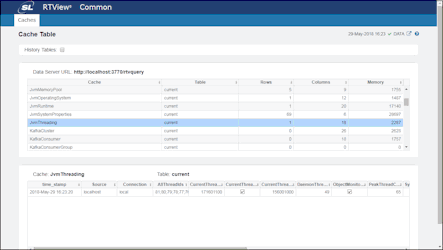RTView Data Server for Kafka Quick Start Guide, Version 4.1
This document describes the basic steps required to download and install, set up, and run the RTView Data Server for Kafka.
Before You Get Started
- You must have Java installed and you should know the installation directory path.
- You should know the correct full path to the directory containing the Apache Kafka jar files.
- You should know the settings for your Zookeeper connections: Client Port, Host, JMX Port, Username/Password, and Cluster Name.
- You should know the settings for your Broker connections: Client Port, Host, JMX Port, Username/Password, Cluster Name, and Topic Names.
- You should know the settings for your Producer connections: Host, JMX Port, Username/Password, and Cluster Name.
- You should know the settings for your Consumer connections: Host, JMX Port, Username/Password, and Cluster Name.
- You should perform the following steps in your private organization in RTView Cloud.
Downloading the RTView DataServer for Kafka
Log in to your RTView Cloud account at http(s)://rtviewcloud.sl.com.
If you do not have an RTView Cloud account, go to http(s)://rtviewcloud.sl.com/register and follow the instructions to create your account.
Note: If you log in using https, you must use https for your data server links as well. If you log in using http, you can use http or https for your data server links.
Once you have logged in, RTView Cloud displays.
- Click the View tab at the top of the browser, and then click the ? icon in the upper right corner.

The RTView Cloud Support Home page displays.
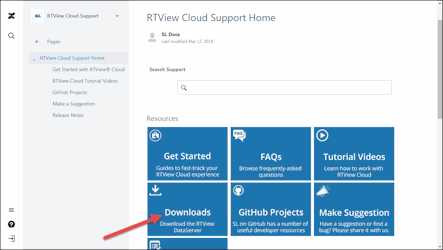
Click the Downloads button.
The RTView Cloud Downloads page displays.
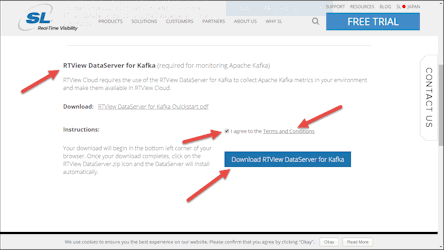
Scroll down to the RTView DataServer for Kafka region and click the Terms and Conditions link to view the SL Corporation - End User License Agreement, click the I agree to the Terms and Conditions check box, and then click the Download RTView DataServer Kafka button.
The RTView Cloud – Dataserver for Kafka Download page displays.
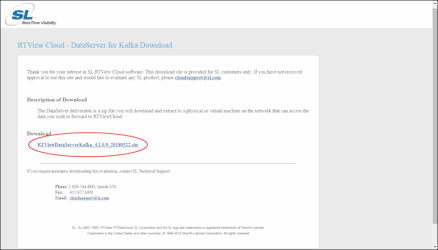
Click the RTViewDataServerKafka_<version>.zip file.
The compressed file is saved to your machine.
Installing and Starting the RTView DataServer for Kafka
Extract All (Windows)/unzip (UNIX/Linux) the file to the directory of your choice. For UNIX/Linux, use unzip -a to unzip the file.
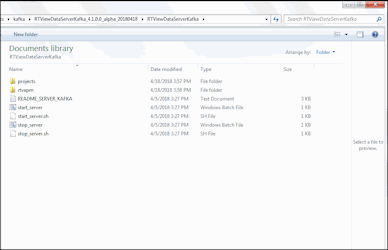
Open a command window and set the JAVA_HOME environment variable to point to your Java Installation. For example:
export JAVA_HOME=/opt/Java/jdk1.7.0 (UNIX/Linux)
set JAVA_HOME=/opt/Java/jdk1.7.0 (Windows)
Or, in Windows, you can set JAVA_HOME as an environment variable (in Control Panel > System > Advanced system settings), where it will then be used by all command windows and when you double-click on a .bat file.
- In the command window, navigate to the RTViewDataServerKafka directory and type:
start_server.bat (Windows)
./start_server.sh (UNIX/Linux)
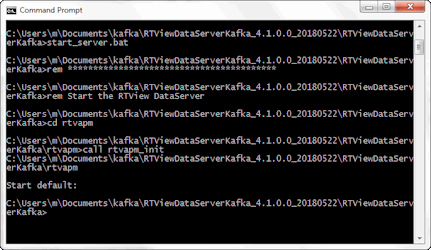
- You can look for the following line in the dataserver.log file in the RTViewDataServerKafka\projects\sample-server\logs directory to verify that the dataserver has started properly:
2018-06-07 15:39:48,272 INFO main - [rtview] 2018-06-07 15:39:48.272:INFO:oejs.Server:main: Started @18396ms
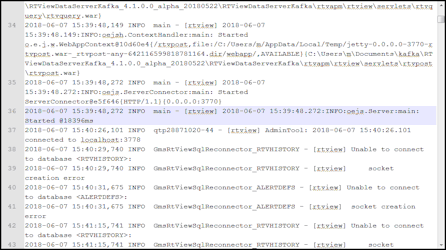
Configuring the DataServer
Next, you need to specify the directory path to your Apache Kafka .jar files and you need to create your connections using the RTView Configuration Application.
- Open a browser and type:
http://localhost:3770/rtvadmin
The Authentication required dialog displays.
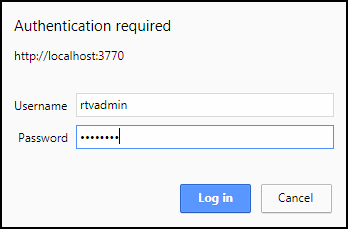
- Log in using rtvadmin/rtvadmin as the username/password.
The RTView Configuration Application displays.
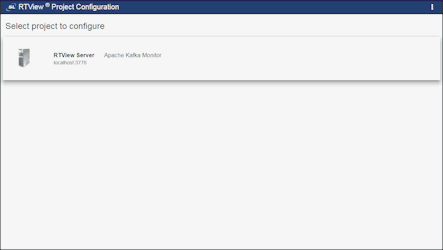
- Click Apache Kafka Monitor.
The RTView Configuration Application displays with the General tab open.
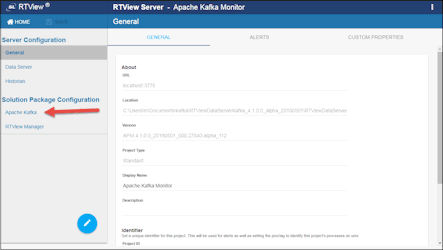
- Click Solution Package Configuration > Apache Kafka.
The CONNECTIONS tab displays.
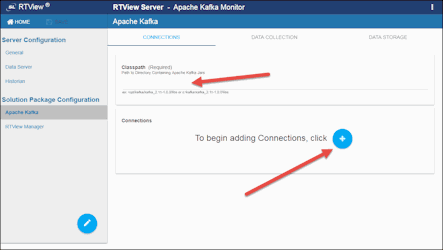
Note: No setup is required for Solution Package Configuration > RTView Manager.
- Enter the correct full path to the directory containing the Apache Kafka jar files in the Classpathfield.
- Click the + button.
The Add Connection dialog displays.
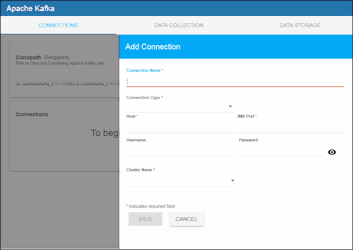
- Add your desired connections and click the Save button after each new connection. You must add at least one Zookeeper and one Broker connection.
Zookeeper Connection
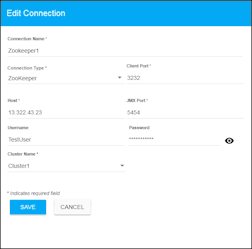
Connection Name: The name of the connection/server.
Connection Type: Select Zookeeper from this drop down list.
Client Port: Optionally enter the Client Port if you want to monitor topic partitions for this cluster.
Host: The IP address of the host.
JMX Port: The JMX port used when connecting.
Username: The username is used when creating the connection. This field is optional (if no username/password is set for the zookeeper).
Password: This password is used when creating the connection. This field is optional (if no username/password is set for the zookeeper). By default, the password entered is hidden. Click the associated "eye" icon to view the password text.
Cluster Name: The name of the cluster.
Broker Connection
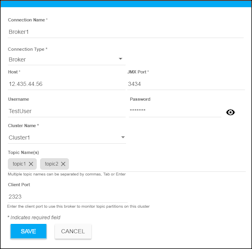
Connection Name: The name of the connection/server.
Connection Type: Select Broker from this drop down list.
Host: The IP address of the host.
JMX Port: The JMX port used when connecting.
Username: The username is used when creating the connection. This field is optional (if no username/password is set for the broker).
Password: This password is used when creating the connection. This field is optional (if no username/password is set for the broker). By default, the password entered is hidden. Click the associated "eye" icon to view the password text.
Cluster Name: The name of the cluster.
Topic Names: Optionally enter one or more topics to restrict monitoring to only those topics on the broker (all topics are monitored by default). You can enter multiple topics by adding a comma or clicking the Tab key after each. Once entered, you can click the X next to the topic name to remove them.
Client Port: Optionally enter the Client Port if you want to use this broker to monitor topic partitions for this cluster.
Consumer Connection
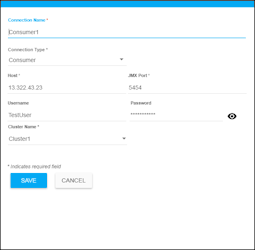
Connection Name: The name of the connection/server.
Connection Type: Select Consumer from this drop down list.
Host: The IP address of the host.
JMX Port: The JMX port used when connecting.
Username: The username is used when creating the connection. This field is optional (if no username/password is set for the consumer).
Password: This password is used when creating the connection. This field is optional (if no username/password is set for the consumer). By default, the password entered is hidden. Click the associated "eye" icon to view the password text.
Cluster Name: The name of the cluster.
Producer Connection
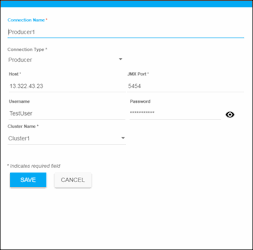
Connection Name: The name of the connection/server.
Connection Type: Select Producer from this drop down list.
Host: The IP address of the host.
JMX Port: The JMX port used when connecting.
Username: The username is used when creating the connection. This field is optional (if no username/password is set for the producer).
Password: This password is used when creating the connection. This field is optional (if no username/password is set for the producer). By default, the password entered is hidden. Click the associated "eye" icon to view the password text.
Cluster Name: The name of the cluster.
- Once you have created all of your connections, click the SAVE button in the RTView Configuration Application.
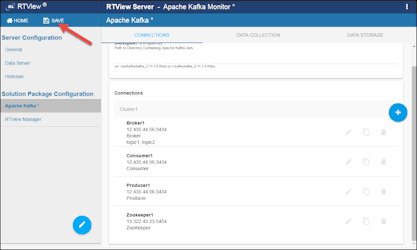
- For your changes to go into effect, you must stop and restart the dataserver from your installation directory by typing the following in your command window:
stop_server.bat (Windows)
./stop_server.sh (UNIX/Linux)
start_server.bat (Windows)
./start_server.sh (UNIX/Linux)
Adding a Solution Package to RTView Cloud
Before you can access the data from the data server in RTView Cloud, you must "add" the desired solution packages to RTView Cloud.
- Click the cog wheel and select the Packages option.
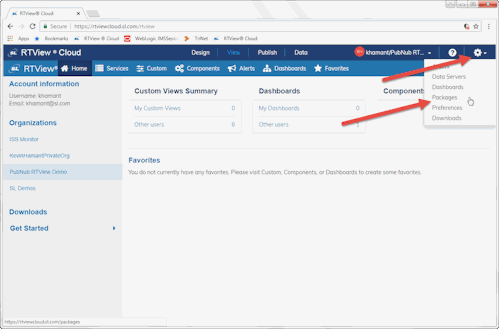
The Solution Packages page displays.

- Click the Select Package button.
The Add Solution Package dialog displays.
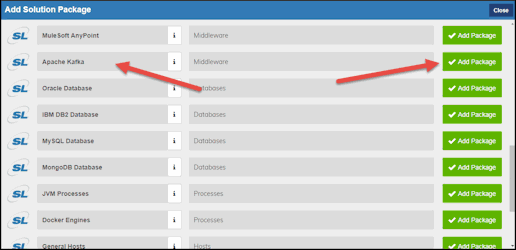
- Scroll down and select the Add Package button next to the Apache Kafka option, and then continue selecting desired solution packages.
The selected solution packages are added to RTView Cloud.

Adding Your New Data Server to RTView Cloud
Before you can view data in RTView Cloud, you need to add your data server via the Data tab. To add the data server:
- Log in to RTView Cloud and click the Data tab at the top of the menu.
The RTData Server List page displays.

- Click the Add RTView Server button, specify the following, and then click Save Added Servers:

Name: Type the name you want to use for the server.
Host/URL: Enter the following: http://localhost:3770/rtvquery
Type: Select Data.
Authorization Type: Do not select an Authorization Type. Leave this option empty.
Once saved, the newly added server displays in the RTData Server List.

Verifying Your Setup
To verify your setup:
- Click View > Components > Middleware > Apache Kafka to view the incoming data.
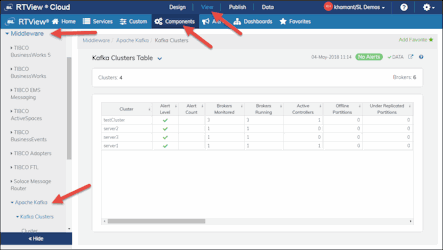
- Once you have set up your connections for your data server, you can verify your setup by accessing the following URL:
http(s)://localhost:3770/common
The RTView Cache Viewer application displays, which allows you to view the details for the caches that are collecting data.
